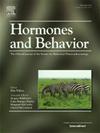睾酮在雄性松雀春季游牧迁徙中的作用
IF 2.4
3区 医学
Q2 BEHAVIORAL SCIENCES
引用次数: 0
摘要
我们对迁移的内分泌调节的理解主要来自强制性迁移的研究,这使得可预测的季节性迁移。对兼性迁移的研究较少,它在时间、距离和方向上变化更大。在专性迁移中,循环睾酮的增加似乎对刺激向春季迁移状态的过渡很重要,尽管睾酮发挥这些作用的机制仍然知之甚少。松雀(Spinus pinus)是一种鸣禽,表现出春季游牧,一种兼性迁徙的形式。利用圈养的雄性松siskin,我们首先测试了循环雄激素刺激(i)生理准备和(ii)游牧迁移行为准备表达的假设。我们发现,与对照组相比,当给鸟类皮下植入外源性睾酮时,它们表现出更大的夜间迁徙不安,但通常没有更大的生理准备。此外,当我们通过皮下植入雄激素受体拮抗剂和芳香化酶抑制剂来抑制睾酮的作用时,这些鸟比对照鸟表现出更少的夜间迁徙不安,尽管两组在生理准备方面没有差异。然后,我们分别给予雄激素受体拮抗剂和芳香化酶抑制剂,测试睾酮的作用是通过激活雄激素受体还是雌激素受体介导的。这一操作提供了一些证据,证明睾酮对迁移性躁动的影响是通过激活雄激素受体发生的,并提示雄激素受体激活在生理制剂中的作用。综上所述,睾酮在刺激雄性松雀春季游牧迁徙行为中起着重要作用。本文章由计算机程序翻译,如有差异,请以英文原文为准。
The role of testosterone in spring nomadic migration of male pine siskins (Spinus pinus)
Our understanding of the endocrine regulation of migration comes primarily from studies of obligate migrants, which make predictable seasonal movements. Less well studied are facultative migrations, which are more variable in timing, distance, and direction. In obligate migrants, an increase in circulating testosterone appears to be important in stimulating the transition to a spring migratory state, though the mechanism by which testosterone exerts these effects remains poorly understood. The pine siskin (Spinus pinus) is a songbird that exhibits spring nomadism, a form of facultative migration. Using captive male pine siskins, we first tested the hypotheses that circulating androgens stimulate (i) physiological preparation and (ii) the expression of behavioral readiness for nomadic migration. We found that when birds were given subcutaneous implants containing exogenous testosterone, they exhibited greater nocturnal migratory restlessness, but generally not greater physiological preparation, compared to control birds. Further, when we inhibited the effects of testosterone by giving subcutaneous implants of androgen receptor antagonist and aromatase inhibitor these birds showed less nocturnal migratory restlessness compared to control birds, though the groups did not differ in physiological preparations. We then tested whether the effects of testosterone are mediated by activation of androgen receptors or estrogen receptors by giving androgen receptor antagonist and aromatase inhibitor separately. This manipulation provided some evidence that the effects of testosterone on migratory restlessness occur via activation of androgen receptors and suggested a role for androgen receptor activation in physiological preparations. Overall, the results indicate a role for testosterone in stimulating spring nomadic migratory behavior in male pine siskins.
求助全文
通过发布文献求助,成功后即可免费获取论文全文。
去求助
来源期刊

Hormones and Behavior
医学-行为科学
CiteScore
6.70
自引率
8.60%
发文量
139
审稿时长
91 days
期刊介绍:
Hormones and Behavior publishes original research articles, reviews and special issues concerning hormone-brain-behavior relationships, broadly defined. The journal''s scope ranges from laboratory and field studies concerning neuroendocrine as well as endocrine mechanisms controlling the development or adult expression of behavior to studies concerning the environmental control and evolutionary significance of hormone-behavior relationships. The journal welcomes studies conducted on species ranging from invertebrates to mammals, including humans.
 求助内容:
求助内容: 应助结果提醒方式:
应助结果提醒方式:


